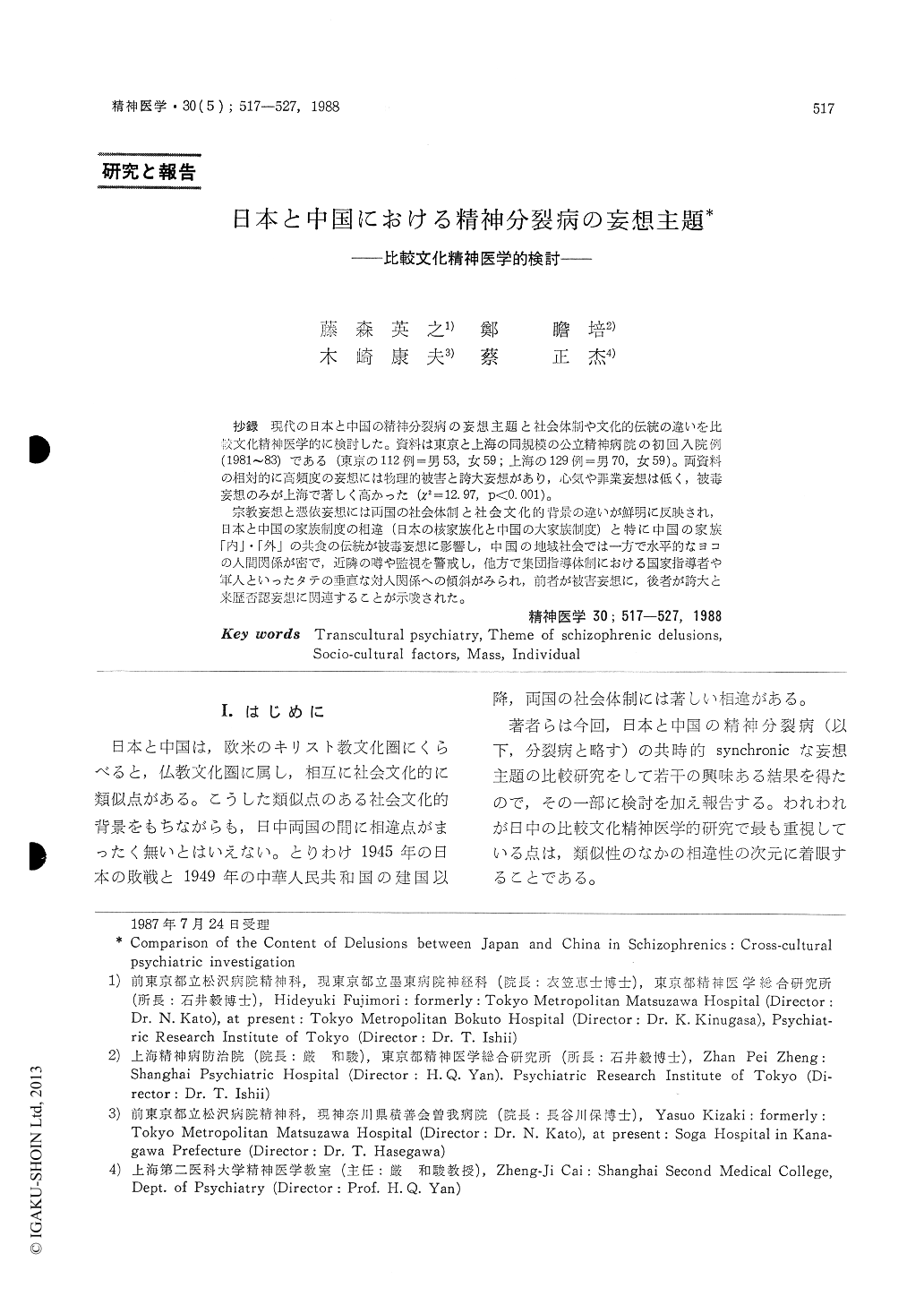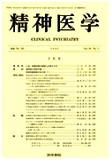Japanese
English
- 有料閲覧
- Abstract 文献概要
- 1ページ目 Look Inside
抄録 現代の日本と中国の精神分裂病の妄想主題と社会体制や文化的伝統の違いを比較文化精神医学的に検討した。資料は東京と上海の同規模の公立精神病院の初回入院例(1981〜83)である(東京の112例=男53,女59;上海の129例=男70,女59)。両資料の相対的に高頻度の妄想には物理的被害と誇大妄想があり,心気や罪業妄想は低く,被毒妄想のみが上海で著しく高かった(χ2=12.97,p<0.001)。
宗教妄想と憑依妄想には両国の社会体制と社会文化的背景の違いが鮮明に反映され,日本と中国の家族制度の相違(日本の核家族化と中国の大家族制度)と特に中国の家族「内」・「外」の共食の伝統が被毒妄想に影響し,中国の地域社会では一方で水平的なヨコの人間関係が密で,近隣の噂や監視を警戒し,他方で集団指導体制における国家指導者や軍人といったタテの垂直な対人関係への傾斜がみられ,前者が被害妄想に,後者が誇大と来歴否認妄想に関連することが示唆された。
A comparative cross-cultural psychiatric study was performed in order to evaluate the theme of delusions experienced today by schizophrenics in Japan and China, related to their socio-cultural background. The data of this study was derived from the public mental hospitals on a similar scale in Tokyo and Shanghai. The data base was comprised of first-admission schizophrenic cases in each hospital-Tokyo in the period 1981-1983 and Shanghai 1983-(Tokyo: 186 cases=male/ female: 88/98; Shanghai: 200 cases=male/female: 112/88), and the analysis was focused on those cases with delusions (male/female: 53/59 in Tokyo; male/female: 70/59 in Shanghai).
The incidence of delusions of physical persecution and of grandeur was relatively high in Tokyo and Shanghai, while the incidence of delusions with hypochondria and guilt was low. The incidence of delusion of poisoning was significantly higher in Shanghai than in Tokyo (χ2=12.97, p<0.001).
Religious delusion and the delusion of possession reflected vividly a traditional difference of socio-cultural background between Japanese and Chinese patients. A syncretism is seen in Japanese religious delusion, but no Chinese reigious delusion is reported. Japanese delusion of possession closely reflects the belief in the soul of ancestors, but this kind of posssession is not found in China.
After World War Ⅱ, the paternal family structure was abolished in Japan which resulted in change from large families to nuclear families. In Chinese society, paternal family structure is still kept, the members of large families providing labor power and maintaining close human relationships with one another. It was speculated that the appearance of the delusion of poisoning might be a reflection of the custom of eating together inside and outside the family, and sometimes accompanied by trouble in the family or conflicts.
At present, a substantial difference between Chinese and Japanese is self image. In Chinese society, individual-participation in the group for protection and safety is considered as valuable and meaningful. However, in Japanese society there is less conformity with traditions and dependency on the group due to the prevalence of nuclear families.
After World War Ⅱ, the principle of vertical control system was neglected with a consequent loss of authority in Japan because values changed widely. In the local Chinese community, a close horizontal relationship and caution against rumor and a feeling of the need for neighbourhood help may affect the occurrence of the delusion of persecution. In addition, unconscious desire for superiority among directors and soldiers within the mass of the people may have influenced the content of delusion of grandeur and delusion of negation of the family in China. It is suggested that the different social organizations and socio-cultural backgrounds have influenced the content of delusions in schizophrenia in both countries.

Copyright © 1988, Igaku-Shoin Ltd. All rights reserved.


